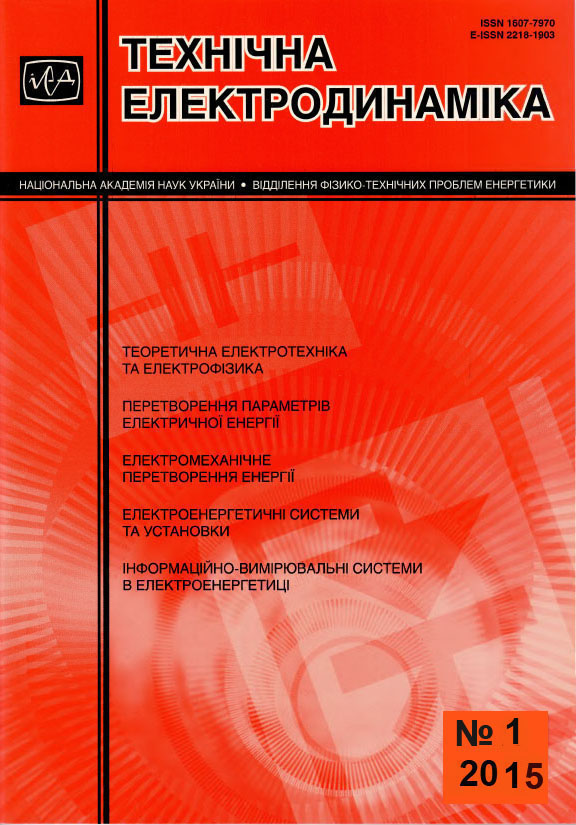Abstract
This article is devoted to the development of active power factor corrector based on the parallel quasi-resonant pulse converter with zero current switching of the power transistor. The features of the structural realization of the converter control system have been considered by analyzing of steady-state current static errors for different possible structures. In contrast to the power factor correctors with voltage loop as the main, where the process of finite duration is set for five cycles, in the power factor corrector with current loop as the main it is set for three cycles. It was shown, that high-frequency two-loops active power factor correctors based on the parallel quasi-resonant pulse converter with zero current switching is advisable to carry out with current loop as the main, in which the regulator must ensure the implementation of processes of finite duration. References 15, table 1, figures 4.
References
Belov G.A. Dynamic models of multiphase boost pulse converter // Elektrichestvo. – 2010. – № 6. – Pp. 21–28. (Rus)
Belov G.A., Serebriannikov A.V. Power factor corrector calculation with switching on power transistor at zero current // Elektrichestvo. – 2012. – № 3. – Pp. 45–56. (Rus)
Belov G.A., Serebriannikov A.V. Input current distortion in power factor corrector with two-loops control system // Elektrichestvo. – 2010. – № 8. – Pp. 42–51. (Rus)
Denisov Yu.A. DC voltage stabilizers with pulse-width modulated and frequency modulated quasi-resonant converters. – Kyiv: Instytute of Elektrodynamiks National Akademe of Sceince of Ukraine. – 2001. – 147 p. (Rus)
Stepenko S.А. Energy efficiency analysis in power factor corrector under different pulse-width modulation modes // Tekhnichna Elektrodynamika. – 2014. – №4. – Pp. 78–80. (Ukr)
Stohnii B.S., Kyrylenko O.V., Denysiuk S.P. Smart electrical grids of power systems and their technological support // Tekhnichna Elektrodynamika. – 2010. – №6. – Pp. 44–50. (Ukr)
Shydlovskyi A.K., Zharkin A.F., Pazeev A.G. Continuous approximate model of AC/DC converters with active power factor correction // Tekhnichna Elektrodynamika. – 2011. – №6. – Pp. 11–17. (Ukr)
Andreycak B. Power factor correction using the UC3852 controlled on-time zero current switching technique. Application note U-132. – 1999. – Pp. 3-235-3-251.
Denisov Y., Stepenko S. Power factor corrector based on parallel quasi-resonant pulse converter with fast current loop // Electrical, Control and Communication Engineering. – 2013. – Volume 3. – Issue 1. – Pp. 5–11.
Denisov Y.O., Stepenko S.A., Gorodny A.N., Kravchenko A.O. Input current parameters analysis for PFC based on quasi-resonant and conventional boost converters // Proceedings of the IEEE 34th International Conference on Electronics and Nanotechnology (ELNANO-2014), April 15-18, 2014, Kyiv, Ukraine. – 2014. – Pp. 393–397.
Firmansyah E., Abe S., Shoyama M., Tomioka S., Ninomiya T. An active-clamped full-wave zero-current-switched quasi-resonant boost converter in power factor correction application // 25th Annual IEEE Applied Power Electronics Conference and Exposition (APEC), 21-25 Feb. 2010, Palm Springs, CA, USA. – 2010. – Pp. 30-35.
Firmansyah E., Tomioka S., Abe S., Shoyama M., Ninomiya T. Zero-current-switch quasi-resonant boost converter in power factor correction applications // 24th Annual IEEE Applied Power Electronics Conference and Exposition (APEC), 15-19 Feb. 2009, Washington, DC, USA. – 2009. – Pp.1165-1169.
Texas Instruments. Power Management Guide. 3Q. – 2008. – 77 p.
Texas Instruments. UC1852/UC2852/UC382 high power-factor preregulator. 10/94. – 2008. – 10 p.
Todd P.C. UC3854 Controlled power factor correction circuit design. U-134. – 1999. – Pp. 3-269-3-289.

This work is licensed under a Creative Commons Attribution-NonCommercial-NoDerivatives 4.0 International License.
Copyright (c) 2022 Tekhnichna Elektrodynamika

